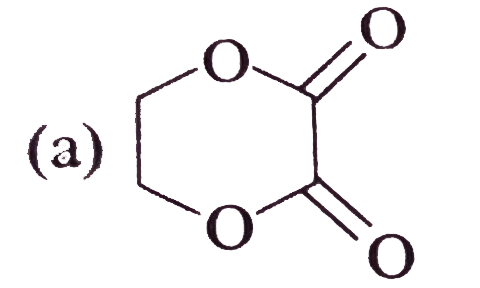Ethylene gylcol gives oxalic acid on oxidation with
Acidified K2Cr2O7
Acidified KMnO4
Alkaline KMnO4
Periodic acid
The correct Answer is:A
To determine the oxidizing agent that converts ethylene glycol into oxalic acid, we can follow these steps:
Step 1: Identify the structure of ethylene glycol
Ethylene glycol, also known as ethane-1,2-diol, has the chemical formula C2H6O2. Its structure consists of two hydroxyl (-OH) groups attached to a two-carbon chain.
Step 2: Understand the oxidation process
Oxidation involves the loss of electrons or an increase in oxidation state. In the case of ethylene glycol, the hydroxyl groups can be oxidized to form carbonyl groups, which can further oxidize to carboxylic acids.
Step 3: Recognize the product of oxidation
When ethylene glycol is oxidized, it can form oxalic acid (C2H2O4). Oxalic acid contains two carboxylic acid groups (-COOH) and is the simplest dicarboxylic acid.
Step 4: Identify suitable oxidizing agents
Common oxidizing agents that can oxidize alcohols to carboxylic acids include:
- Acidified potassium dichromate (K2Cr2O7)
- Periodic acid (HIO4)
Step 5: Conclusion
Among the oxidizing agents mentioned, acidified potassium dichromate (K2Cr2O7) is a well-known strong oxidizing agent that can effectively oxidize ethylene glycol to oxalic acid.
Final Answer
Ethylene glycol gives oxalic acid on oxidation with acidified potassium dichromate (K2Cr2O7).
---
Ethylene glycol, also known as ethane-1,2-diol, has the chemical formula C2H6O2. Its structure consists of two hydroxyl (-OH) groups attached to a two-carbon chain.
Oxidation involves the loss of electrons or an increase in oxidation state. In the case of ethylene glycol, the hydroxyl groups can be oxidized to form carbonyl groups, which can further oxidize to carboxylic acids.
When ethylene glycol is oxidized, it can form oxalic acid (C2H2O4). Oxalic acid contains two carboxylic acid groups (-COOH) and is the simplest dicarboxylic acid.
Common oxidizing agents that can oxidize alcohols to carboxylic acids include:
- Acidified potassium dichromate (K2Cr2O7)
- Periodic acid (HIO4)
Among the oxidizing agents mentioned, acidified potassium dichromate (K2Cr2O7) is a well-known strong oxidizing agent that can effectively oxidize ethylene glycol to oxalic acid.
Ethylene glycol gives oxalic acid on oxidation with acidified potassium dichromate (K2Cr2O7).
Topper's Solved these Questions
- ALCOHOL, PHENOL AND ETHERBOOK - ERRORLESS CHAPTER - ALCOHOL, PHENOL AND ETHEREXERCISE - Ordinary thinking (Ojective questions) Uses of Alcohol, Phenol and Ethers
20 Videos
- ALCOHOL, PHENOL AND ETHERBOOK - ERRORLESS CHAPTER - ALCOHOL, PHENOL AND ETHEREXERCISE - Critical Thinking (Objective Questions)
17 Videos
- ALCOHOL, PHENOL AND ETHERBOOK - ERRORLESS CHAPTER - ALCOHOL, PHENOL AND ETHEREXERCISE - Ordinary thinking (Ojective questions) Preparation of Alcohol, Phenol and Ethers
46 Videos
- ALDEHYDES AND KETONES BOOK - ERRORLESS CHAPTER - ALDEHYDES AND KETONES EXERCISE - JEE Section (JEE (Advanced) 2018) Numeric answer type question
1 Videos
Similar Questions
Knowledge Check
Ethylene gives epoxy ethane on oxidation with
AKMnO4/OH−BK2Cr2O7/H+CAg2O/200∘CDH2SO4/170∘CEthylene gives epoxy ethane on oxidation with
AKMnO4/OH−BK2Cr2O7/H+CAg2O/200∘CDH2SO4/170∘CWhen ethylene glycol is heated with oxalic acid in this presence of conc. H2SO4, the product formed is:
A B
B C
C D
D
When ethylene glycol is heated with oxalic acid in this presence of conc. H2SO4, the product formed is:
View SolutionEthylene glycol on oxidation with periodic acid gives
View SolutionEthylene glycon an oxidation with periodic acid gives :
View SolutionWhich of the folloiwng gives oxalic acid ?
View SolutionOxalic Acid Is Found In -
View Solution
